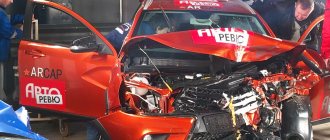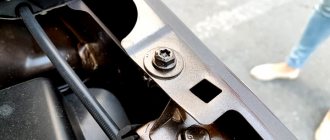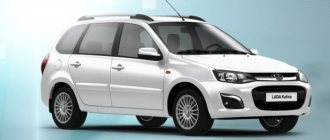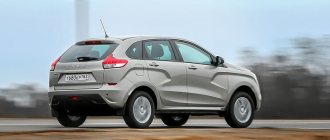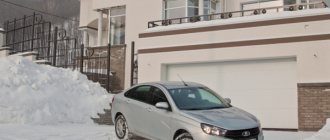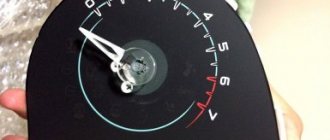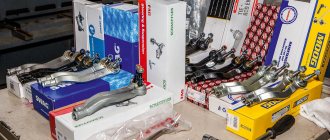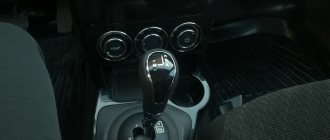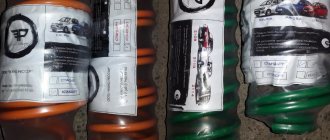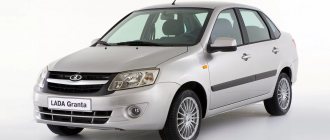Representatives of AvtoVAZ, who arrived for our Vesta crash test, respectfully called this gray-haired German “Doctor” - as is customary in Germany to address people with an academic degree. Before moving to Tolyatti in February last year, the Doctor held a high position in the development department of a very serious German concern. And, probably, his obligations to this company implied a “non-disclosure agreement” even after the end of the contract. Otherwise, why would the VAZ people insist that we not mention the Doctor’s name and not publish photographs? So let’s just call him Doctor X. The task before him was not an easy one: to bring Vesta’s passive safety to three stars in the Euro NCAP rating and to four “our” ARCAP stars. Happened?
- Ernst Glas? Of course I know him,” Doctor X was not embarrassed by my question.
Let me remind you that it was Ernst Glas who was sent from Wolfsburg to our crash test of the Volkswagen Polo (AR No. 23, 2010). The German sedan then earned 14.3 points out of 16 possible and the maximum four ARCAP stars - the best result in the entire history of Autoreview crash tests.
We purchased our Vesta before the New Year - and not in Moscow, but in Perm, in order to nip all speculation about special training in the bud. True, we had to deviate from our rules and buy a car for 570 thousand rubles in the Comfort configuration with two airbags: the basic Classic versions with one driver’s airbag were simply not on sale at that time. But while we were asking the engineers how to correctly disable the passenger airbag, VAZ decided that the “basic” Vesta would also have two airbags.
What was the real reason? The desire of buyers, as the VAZ directorate claims, market conditions (this is the version of the PR department) - or did Tolyatti decide at all costs to get a high result in our ARCAP rating? After all, the cheat sheet for sellers sent to dealers in November indicated that Vesta with one pillow scores three ARCAP stars, and with two, four.
Regardless of the motives, the step is worthy of praise: the car has a priori become safer.
And this is just one of the mini-detectives related to the passive safety of the new VAZ model.
Another example. Ten years ago, the very first prototype of Project C (many developments on it formed the basis of Vesta) immediately scored 13 points out of 16 possible for a frontal strike according to the Euro NCAP method (AR No. 12, 2006). And a year ago, some VAZ workers answered the question “How’s Vesta?” They answered: “No way. Recently they hit it and it fell apart. The bosses said they wouldn’t let Vesta and I work, they would take us to Spain.”
Maybe that’s also why these engineers no longer work at VAZ?
The official version says that the body was calculated using mathematical models, and in the power structure, “five new grades of high-strength steel were finally used.” In addition to Tolyatti, work on the rigidity of the cabin “cage” and the energy-absorbing properties of the side members was carried out at the research centers IDIADA (Spain) and UTAC (France). Abroad, by the way, all the work on the “soft” hood and front bumper was completed: VAZ still does not have its own installation for checking the safety of pedestrians. And the pillows and pyro-tensioning belts were calibrated by Takata. It is the company that currently supplies restraint systems for all VAZ models. The Swedish Autoliv is being considered as an alternative: in Togliatti, the scandal with the spontaneous deployment of Takata airbags, which ended last year with a record recall for the United States of 34 million cars of Japanese, American and European brands, was not ignored.
The stakes on Vesta are high, and with the fall of the ruble it has only increased: the economic salvation of the project must be sought in external, including European, markets. That’s why Doctor X was invited to VAZ. And that’s why dozens of prototypes were destroyed - several times more than during the development of Grants (AR No. 18, 2012). For the same reason, the VAZ delegation was so representative: three engineers checked the landing of the dummies before the impact. By the way, the aforementioned Ernst Glass recommended putting the back of the seat more vertical in the Polo sedan and raising the upper seat belt fastenings to the extreme position. But Dr. X did not bother to optimize the fit: the belts remained installed in the middle position - and the standard 25° backrest tilt from the vertical.
We carried out a crash test at 64 km/h with a 40% overlap at the NAMI test site near Dmitrov. Firstly, with the current euro exchange rate it is cheaper than abroad. And secondly, the testing laboratory has been significantly modernized in recent years. To accelerate the car, a new electric motor is now used, which does not require a long wait for the flywheel system to spin up and allows it to more accurately maintain a given speed - it is now controlled by a modern optical system. In addition to the pair of Hybrid III mannequins, another one, the latest modification, was purchased. And the problem with the thermal dependence of sensors, primarily calibrated fins (their deformation is correct only at temperatures of 19-22 ° C), at 16 degrees below zero outside, was solved with the help of heat guns and gas heaters installed at the starting position at the beginning of the covered but unheated acceleration stripes.
Pre-production testing of LadaVestaCrossSport
Even before serial production of cars started, comprehensive testing began. It was the month of May 2021. One of these tests was attended by analysts from Autoreview, an authoritative publication trusted in the automotive world. Then the car was tested during a side impact on a ram weighing nine hundred kilograms, there was also a removable tip, and the speed was 50 km/h.
The test vehicle was the most fully equipped car, which contained four airbags. The result exceeded all expectations, and the AVTOVAZ designers were proud of it. Most of the impact energy was absorbed by the threshold, the performance of the side airbags fully met expectations, and the rear windows were not damaged in principle, which cannot be said about the driver's window.
AVTOVAZ reports say that the sensors attached to the driver’s dummy did not detect excessive load. According to HIC (hydrogen induced cracking) standards, which indicate head trauma, a good result was obtained. One Autoreview expert noted an interesting feature. The manufacturer did not test the Cross station wagon version with the luggage compartment loaded, although such a test would seem necessary. Such a test would show how securely the oversized luggage located above the window line is fixed. AVTOVAZ explained why they decided not to conduct such a crash test on the Lada Vesta Cross sw. The reason lies in the very purpose of the car, because it is not designed to transport goods, but is an SUV that has increased cross-country ability, but nothing more.
Insurance test
This type of crash test, also called the Danner test or the bumper test, consists of a car colliding with its front side at a speed of 15 km/h with a non-deformable barrier that imitates the bumper of a standing car.
The AutoReview publication conducted an insurance test for the Lada Vesta in the passive safety laboratory at the Dmitrovsky test site to demonstrate the consequences of a typical accident in urban conditions involving a sedan. A Vesta at a set speed of 15 km/h with ballast weighing 50 kg in the trunk was collided with a stationary obstacle simulating a bumper, blocking the front of the sedan on the left by 40% and located at an angle of 80 degrees to the axis of the car.
The purpose of this test is to show how serious it will be for Vesta and how expensive it will be for the car owner to repair after a minor accident in the city, when the car “catch up” with the car in front or run into a standing one - the safety of the car also has an economic component. Based on the results of the bumper test, we compiled costing of repairs in official and regular auto repair shops.
Damage during an insurance crash test
After the impact, the driver's door opened absolutely freely, the hood was opened with little effort, but without improvised means, no leaks of working fluids were observed.
The bumper is destroyed, and its restoration is impractical - only replacement. The broken left headlight moved back and slightly crushed the front part of the fender, and the upper front cross member under the hood also moved towards the engine. Oddly enough, the radiator grille was preserved intact, except for one latch, and its upper mount was torn out of place. At the same time, the radiator itself is not damaged, only the honeycombs are slightly crumpled, which indicates that its brackets are designed to be torn while preserving the unit itself.
The transverse front beam is deformed, the left supporting part is crushed almost to the maximum, but the geometry of the side members is not broken, which also indicates that the Lada Vesta uses the method of shock-absorbing deformations incorporated into the design.
The beam has no welded joints with the spar, so replacing it will not weaken the rigidity of the elements due to heating during cutting and welding.
Repair costs
Repair of the described damage to the Lada Vesta from an official dealer will cost the following amount:
- repair and restoration work - 40 thousand rubles;
- spare parts and components – 70 thousand rubles.
Total – 110 thousand rubles. with a 1 month wait for parts to arrive.
At a regular car service center, the cost of restoring Vesta will be:
- work - the same 40 thousand rubles;
- spare parts – 20 thousand rubles.
Total – 60 thousand rubles.
The fact is that the official dealer planned to restore only the front left fender, the remaining damaged parts were to be replaced with new ones. And during repairs at a regular service center, you would only have to buy a new headlight, crossbar and chrome bumper trim. All other parts were planned for restoration.
If we analyze the cost of similar repairs of foreign car brands in relation to the cost of a new car, we will get the following picture.
The conclusion from the comparison of ratios is that repairing Lada Vesta at universal service stations after the expiration of the warranty period is more attractive compared to the situation with restoring foreign cars.
Crash test Lada Vesta SV cross – production version
As soon as sales of the car started, station wagons, which were classified as production models, were tested. To assess the consequences of a frontal impact, the ARCAP method (frontal collision with an obstacle at a speed of 64 km/h) was used, and the test was carried out by representatives of the Autoreview publication. A test of the consequences of a side impact was carried out on a specially equipped territory of the AVTOVAZ plant. Repeated full-cycle tests were necessary, since both the ground clearance and weight of the production car had increased.
Who is Danner?
The “insurance” crash test methodology was developed back in the 70s of the last century at the initiative of the international organization for auto repair RCAR (Research Council for Automobile Repairs). The founders, by the way, were the Scandinavians: back in the 60s, on the instructions of the chief of the largest Swedish insurance company Folksam, Claes Back, the Car Repair Committee was created, which began developing a system of ratings for the cost of restoration repairs after an accident that influenced the price of insurance. The Swedish committee quickly grew into a Scandinavian one, then the German research center Allianz Zentrum fur Technik (AZT) and the British research institute Thatcham joined it.
The crash tests themselves were developed under the leadership of AZT executive director Professor Max Danner (hence the second common name for RCAR tests - Danner crash test) together with Mercedes-Benz. The European insurance rating is made up of three ratings: for impacts from the front, rear and side. At Autoreview we use only one RCAR crash test - frontal. Speed - 15 km/h, non-deformable barrier is rotated 80° to the longitudinal axis of the car, overlap at the moment of collision - 40%. It is this type of impact that simulates the most typical urban accident involving a collision with a car in front.
Vesta Cross frontal impact test
Representatives of “Autoreview” purchased a car specifically for testing for 798,000 rubles, which ended up being badly damaged. To assess the consequences, it was necessary to organize a frontal collision with deformable ceilings, speed – km/h. Even before the start of the procedure, specialists noted the presence of large wheels, which is a clear advantage of the car. The top version of the Cross station wagon is equipped with 17-inch wheels, but the sedan can only boast 15-inch wheels. Experts measured the mass of the car, it turned out that it weighs 148 kg more than the sedan, so energy absorption was expected to be 13% more.
Specialists from the manufacturer’s plant were also invited for testing. The first impression after the collision was that the car withstood it perfectly. Due to the additional amplifiers, there was no displacement of the front pillar, and excellent performance of the left spar was noted - it turned out to be folded, and this made it possible to absorb a significant part of the impact energy. One of the alloy wheels cracked from the energy, but also took part of the impact. The excellent work of ERA-GLONASS is noted; almost instantly after the collision, a company employee got in touch. There was virtually no effort required to open the driver's door, and the airbag deployment was also excellent. The table shows what damage the mannequins in the front row received:
| Head and cervical injuries | None. Norm. When the car bounced off during the collision, the driver's head turned, but without any damage to his health. |
| Knee injuries | A slight impact of the right knee on the dashboard, no contact of the left knee with the plastic is noted |
| Damage to the chest compartment | None. The seat belts worked well, the compression force was assessed as normal. During the collision, the steering wheel moved away from the person by thirty millimeters |
| Foot injuries | None. The pedal assembly has moved slightly, but there is no danger to health. |
According to the results of this testing, the car is resistant to frontal impact and received a high score. However, if you test a car according to the progressive European methodology Euro NCAP, the result is not so good, since it is also necessary to evaluate the structural integrity of the passenger seat in the cabin. After removing the decorative plastic that covers the area of the sills and wings, a number of creases in the metal of the rear and front sills are clearly visible. It is known that since 2016, the plant has modified the front sills in cars using thicker metals. Representatives of Autoreview decided to cut the threshold and remove the external linings - as it turned out, the deformation also affected the power unit itself.
After that, we decided to start removing the floor sound insulation, under which a torn floor appeared, that is, the legroom was destroyed, and this is already a reason to deduct one point. The ruptures occurred exactly at the points, but there were no complaints about the welding. Consequently, the sheet metal supplied to AVTOVAZ is not of sufficient quality. The floor of the car under the driver's seat was also deformed, it was raised, and this was an excessive load on the shin area. As a result, the crash test of the Lada Vesta SV Cross actually failed - it earned only a satisfactory rating. The maximum score was 16 points, and Vesta got only 11.7. Minuses were received for the following reasons:
- The lower legs are not sufficiently protected.
- The floor is deformed, according to Euro NCAP standards, this indicates that the doorway is not stable.
- The threshold broke and the dummy hit the plastic steering column. Although it is not dangerous, the plastic covers a number of metal components.
The car was given only three stars.
Crash test result from Autoreview: LADA Vesta is a safety champion
We can speak with confidence about the safety of the Lada Vesta after the Lada Vesta passed a crash test conducted by the Atoreview publication.
According to the results of this crash test, the new sedan received a high score of 4 ARCAP stars.
Now the car can be confidently called the safest representative on the Russian market.
As a result of the crash test, Vesta's cage did not undergo deformation. The doorway decreased by only 4 mm. Minor changes were felt in the steering column and pedals. Belts equipped with pyrotechnic tensioners and airbags worked flawlessly.
Mikhail Podorozhansky, editor-in-chief of Autoreview and head of an independent crash test, said that the Lada Vesta was made taking into account all safety requirements. The high quality of parts and connections is admirable. In comparison with other domestic cars, the new sedan has achieved maximum results that are not yet available to its analogues.
The President of AvtoVAZ thanked the representatives of Autoreview for the high professionalism with which the crash test was carried out. However, Bo Andersson said that AvtoVAZ expected a similar result. Over the previous two years, Lada Vesta passed 150 virtual and more than 30 real crash tests. The latest test only confirmed earlier studies. Now we can say with confidence that the LADA Vesta sedan fully meets international safety standards.
The car, which passed the tests, was purchased by the Autoreview publication in December last year in Perm. This sedan corresponds to the “Comfort” package, but the safety system is similar to the minimum “Classic” package.
The crash test conducted by ARCAP involves an oblique frontal impact of the car on an obstacle at a speed of 64 km per hour. LADA Vesta became the 35th car included in this program.
How AVTOVAZ reacted to the test results
The engineers were really puzzled by the results; they decided to buy back the car that was broken during testing in order to examine it, since there was a possibility of defects during the assembly process. However, this option was not confirmed. Then they carried out computer modeling and compared the test results at the plant site and the result of the Autoreview test. It turned out that the reason for this behavior of the car in a collision was ballast. There is an algorithm for preparing a car for testing.
| Weight on front seats (dummy weight) | 88 kg each |
| Indicator of tank fullness with gasoline (gasoline is replaced with water) | 90 % |
| Ballast weight on the rear seat | 32 kg |
| Weight in the luggage compartment required for testing the equipment | 36 kg |
When testing was carried out at the factory, 2 child seats and 2 child dummies were installed on the rear sofa, but in the external test they used metal ingots that were screwed to the floors. The weight of each ingot is 20 kg. Permission to use this approach is given by Euro NCAP standards only when there is a guarantee that it will not affect the test results. A mathematical model was created, and engineers found that the use of two ingots, each weighing twenty kilograms, affected the load on the reinforcements and welds, increasing it by 20%. That's why the floors were deformed.
Crash test of Lada Vesta Cross during a side impact
Again, the test result is influenced by the evaluation criteria, as in frontal collisions. Side impacts were already tested at the manufacturer’s premises; we took the top-end version of the station wagon. He will participate in a collision with a cart that weighs 950 kg, has a crushable barrier, and speeds 50 km/h. The central part of the car was chosen for impact. The manufacturer talked about a side cushion that was sewn into the seat backs; in the event of a collision, it should open up, cover the window opening by almost half, and the protection will affect not only the body, but also the head.
After the collision, ERA-GLONASS representatives contacted the car 27 seconds later, which is very prompt. Given the shift in the center of gravity closer to the front, a slight turn of the stern was expected. The driver's window was completely broken, but the rear windows and mirror were not damaged. The chief engineer personally expressed his impression of the test, calling it a success. He noted the timely opening of the side airbag, while experts began assessing the damage in the cabin, recording the forces when opening the doors and other analyses. Only after this they begin checking the condition of the mannequin. When the project was just being worked out, AVTOVAZ employees decided to strengthen the thresholds, because the car’s ground clearance had increased, so it was the threshold that would have to absorb the impact energy. Only with the help of reinforcement could it be possible to minimize the effect of the threshold on the central pillars and the likelihood of their displacement. This was a successful crash test of the Lada Vesta Cross - the video is clear evidence that there were no problems opening the doors after the collision, gasoline did not spill out of the tank, and the dummies did not receive serious injuries, especially since even a tool was not needed to remove them. The battery was intact, there were no dangerous parts in the cabin, and according to the injury criteria, they were all below the threshold standards. The manufacturer does not yet plan to test the car with a full luggage compartment or heavy loads, considering this not so necessary. It is important to note that the European Union already has stricter assessment standards, and Vesta was tested according to standards that were developed back in the eighties. For example, using a cart weighing 950 kg is considered irrelevant. Since almost all modern cars weigh more than a ton. According to the Euro NCAP standard, the weight limit is 1 ton and 300 kg, but the assessment standards are the same.
Bumper crash test
This test, which also has another name - the Danner technique (insurance test), consists of accelerating a car to 15 km/h, and then crashing its front bumper into a static barrier (similar to a real bumper of a stationary car).
The test using Danner’s method was carried out by employees of the Autoreview magazine at the test site near Dmitrovskoe Highway in the passive safety laboratory. The purpose of the test is to clearly show the results of an average sedan collision in an urban area. The car was accelerated to 15 km/h, while its trunk contained a specially placed load weighing 50 kg. The fixed barrier took the impact of the car in the following way: the front part of the Vesta was blocked on the left by 40%, while the artificial obstacle was at an angle of 80% towards the axis of the car.
The testers set out to determine how great the financial losses would be for the Vesta owner in the event of a collision between the car and a car driving in front (or in the event of a collision with a stationary one). From the financial side, the results of the test were reflected in the drawn up work plan, moreover, in two versions: at an official dealer and at an average service center.
How are the tests carried out?
According to ARCAP, the crash test is a frontal collision of a car at a speed of 64 km/h with a deformable barrier that simulates the front of a passenger car using aluminum particles. Statistics show that direct collisions are rare, so testing involves hitting the car with an obstacle from the front. Where is the driver? The established overlap size is 40%. This is the ability to simulate an offset, head-on collision between two vehicles having almost the same mass.
Total speed – 110 km/h. 2 mannequins are seated in the cabin, and with the help of sensors installed on them, information about the overloads that act upon impact on such parts of the body as the head, lower leg, chest, kneecaps and hip area is recorded. They examine information on the driver and front row passenger, calculating what injuries they may receive. And with what probability? The calculation takes into account the movement of the steering wheel, the shift of the front left pillars and pedals. Such testing is possible at AVTOVAZ in the Russian Federation, as well as in the Czech Republic, thanks to the specialists of TÜV SÜD Czech
Frontal kick
Technical information before the test
We will break down a car with the maximum configuration, costing almost 800 thousand rubles. Its safety cage, if you can call the cabin that way, is identical to the regular Vesta. Therefore, you shouldn’t expect a miracle from her in a frontal attack.
I wonder how different the crash test results of the Vesta Cross will be from the sedan? It is worth remembering that in previous tests, the sedan received 4 stars and 14.1 points out of 16 possible according to Autoreview. It takes 3rd place in the safety rating of people's cars, behind the Polo Sedan and Hyundai Solaris.
But over the course of several years, certain changes have occurred in the design of Vesta, which should improve the passive safety in the Cross version:
- An amplifier is installed in the arch of the windshield, which extends to the middle of the doorway.
- The sills, which in the sedan collapsed upon impact, have been strengthened.
- 4 airbags. But those installed in the backs of the front seats are unlikely to play a decisive role in a frontal impact.
Increased ground clearance, larger rims and the weight of the car, which is 148 kg more than the Vesta sedan, can significantly affect the crash test results. We are watching carefully and waiting for the results.
Video of the Lada Vesta SV Cross crash test - frontal impact:
results
In appearance, the SV Cross withstood the crash test well. The windshield pillar is in place and not wrinkled. The left spar worked better than on the sedan - it folded like an accordion, taking away a significant part of the frontal impact. The large cast disk broke and became deformed, absorbing some of the energy.
Click on the picture to enlarge it
The driver's side sill is quite crumpled. Although VAZ engineers specially strengthened it in 2021, this will take away several points from the Cross based on crash test results. Having removed the floor mats and soundproofing mats, we discovered that the floor under the driver’s seat had “heaved up” and torn. In places of spot welding, the metal is connected reliably, but even there it was torn.
The driver's door opened almost without problems. At first glance, everything in the cabin looks decent. The driver and passenger survived. Let's see what damage they received. The head and neck were not injured; they were protected by airbags, which they clearly hit. The chest was not injured, the seat belt held it with the necessary force, the ribs were compressed less than in the Vesta sedan. The steering wheel has moved 30 mm away from the driver - just like in modern cars. The left knee did not touch the panel, the right knee was slightly injured on the plastic parts of the interior. The mannequin's feet are intact. Although the pedal assembly moved into the cabin during a frontal impact, the amount of its movement was not significant, in comparison with the UAZ Patriot, where the pedals “turned” the driver’s feet in the other direction.
Lada Vesta Cross safety level
If we evaluate the test result according to the criteria of the Russian plant with child dummies, then it turned out to be simply excellent. There are no floor breaks at the welding points, the thresholds are not swollen or broken. Experts were able to prove that the unsuccessful scores obtained in the external test were due to the fault of Autoreview representatives. The use of twenty-kilogram ingots affected the final results, as they increased the load on the floors. When testing at AVTOVAZ, Vesta SW Cross was able to receive not only 14.9 points, but also a maximum of 4 stars. The car has high safety scores, more than the Lada Kalina, which scored only 10.1 points, and the Grant with a score of 10.7 points.
